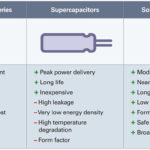Wireless sensor nodes, wearables, trackers, and displays are typical devices that can be powered using energy harvesting (EH), also called ambient energy, energy scavenging, or power harvesting. The availability of ambient energy for harvesting varies depending on the location and environment where the device is used. Among the many possible sources of ambient energy, the most common include mechanical vibration, light, heat, magnetic induction, and electromagnetic radiation (also called RF).
EH-powered devices are found in a range of application areas, including medical, retail, consumer, and industrial. In the next few years, the various markets for EH-powered devices are poised to experience rapid growth.
Several factors are converging that will drive the growing use of EH, including:
- Energy harvesting is environmentally friendly and reduces or eliminates the need for batteries;
- The costs of harvester devices are declining while the harvesters themselves can produce more and more energy;
- The power needs of wireless sensor nodes and wearables are declining;
- The rollout of 5G networks combined with the narrowband IoT (NB-IoT) will result in the emergence of the so-called Massive IoT.
Energy harvesting choices and applications
The availability of specific energy sources and the relatively small amount of energy produced by most harvesters have a major impact on which harvester technology is employed in a specific application, the architecture of ambient energy-powered devices, and the systems in which the devices are used.

Typical EH-powered devices tend to have peak power needs of 100mW or lower. Some EH-powered devices have peak power needs of 100µW or less. The power demands of a specific device dictate the available choices for potential energy harvesters.

As can be seen from the illustration above, the ability of individual EH technologies to support specific power loads can vary widely in different environments. The chart shows that “Mechanical Movement,” such as in industrial systems, can produce several orders of magnitude more energy compared with “Human Movement.” The same is true for “Outdoor Light” compared with “Indoor Light” and for “Temperature Industrial” and “Temperature Human.” Clearly, the operating environment (indoors vs. outdoors and industrial vs. human body, as just two examples) is a critical factor in determining the potential EH technologies that can be used to power a given device.
Wireless IoT system architectures
Mesh networks are a common wireless architecture used in wireless Internet of Things (IoT) sensor installations. And Zigbee Green Power is an increasingly common standard used to implement those mesh networks. Green Power is a feature of Zigbee that allows for energy-harvesting technology to be used directly with the Zigbee stack. Standard Zigbee uses 20 milli Joule of power per hour, Zigbee Green Power uses only 20 micro Joule per hour.

Massive IoT
According to the GSMA, the rollout of 5G mobile networks promises to be a game-changer for IoT wireless sensors and, by extension, for energy harvesting. The combination of 5G networks and the narrowband IoT (NB-IoT) will enable what’s being called the Massive IoT. Originally developed to use 2G, 3G, and 4G mobile networks, the NB-IoT is a low-power wide-area (LPWA) technology developed to enable a wide range of IoT devices.
Not only will 5G support advanced high-data-rate applications for mobile handsets, but according to Cisco, the number of connected devices will be more than three times the global population by 2022. 5G is designed to support massive machine-to-machine communications. 5G will be capable of supporting up to 1 million devices in a square kilometer. Verizon projects that its 5G Ultra Wideband will eventually handle up to 100 times more connected devices per square kilometer than 4G.
It’s not just the massive number of connected devices on the NB-IoT. In many instances, those NB-IoT-connected devices will be central wireless controllers for mesh networks of dozens (a residential network) or hundreds (industrial or commercial networks) of local wireless IoT devices.
The NB-IoT significantly reduces the power consumption of devices. However, the number of connected nodes is projected to be so massive that it will be unsustainable to power them all with batteries. Managing hundreds of millions of batteries would be costly and logistically challenging. Energy harvesting will increasingly be a necessity.
Part two of this FAQ series compares and contrasts the performance of several of the most common EH technologies. Part three presents integration and power management considerations for using EH with batteries or other energy storage alternatives.
References:
Energy Harvesting, Wikipedia
Energy Harvesting for Low-Power Sensor Systems, Renesas Electronics
Mobile IoT in the 5G Future, GSMA
New Advances in Energy Harvesting Power Conversion, Analog Devices







Leave a Reply